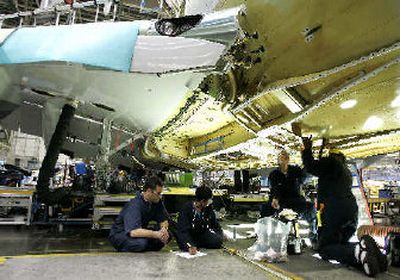Boeing profits off 31 percent

Boeing Co. posted a 31 percent decline in third-quarter profits Wednesday and raised concern on Wall Street about the potential for snags with its much-awaited 787, saying it anticipates spending significantly more than planned to reduce the weight of the fuel-efficient jet.
CEO Jim McNerney acknowledged that weight is “a dogged issue” for the aircraft which, long before its planned debut in mid-2008, has helped Boeing seize momentum and close the gap on Airbus in the commercial airplane market.
But even though the company built in hundreds of millions of dollars of extra costs for the 787, McNerney noted that it is on schedule and insisted that “This plane will be done on time.”
Wary investors pushed the Chicago-based company’s stock lower despite its raised guidance for 2007 earnings and revenue, which reflect a prosperous commercial plane business. Its shares fell $2.73, or 3.3 percent, to close at $80.86 on the New York Stock Exchange.
The red flag for Wall Street was the company’s new forecast of between $3.1 billion and $3.2 billion in research and development spending in 2006 and $3.2 billion to $3.4 billion in 2007 — up from $3 billion for each year. Boeing cited extra costs for not only the 787 but the passenger version of its new 747 widebody jet as its engineers and suppliers tinker with needed changes.
McNerney said the company is trying to be conservative with cost estimates and anticipate contingencies. He also indicated there is a need to take off 2 percent or more of the 787’s weight.
“Forest products company Weyerhaeuser Co. said Wednesday its third-quarter profit fell 26 percent as the downturn in the housing market drove wood product prices and demand down sharply.
Net income fell to $211 million, or 85 cents per share, from $285 million, or $1.16 per share, a year ago. Revenue slipped 2 percent to $5.33 billion from $5.43 billion last year.
Analysts polled by Thomson Financial had expected a profit of 87 cents per share on $5.57 million in revenue.
Weaker prices for lumber, plywood and other wood products caused earnings in Weyerhaeuser’s wood products segment to tumble to $11 million, a 91 percent decline from $124 million in third quarter 2005. The company also said it expects that unit to run an operating loss in the fourth quarter.
Weyerhaeuser, based in suburban Federal Way, posted a $135 million profit in its real estate and related assets segment, down almost 7 percent from $145 million last year.
Shares of Weyerhaeuser slipped 3 cents, to close at $63.70 on the New York Stock Exchange. The stock has been trading between $54.25 and $75.50 over the last year.
Earnings in Weyerhaeuser’s timberlands unit slipped to $178 million, down nearly 7 percent from $191 million last year. The company blamed falling lumber prices and seasonally reduced harvest levels, and warned that it expects fourth-quarter earnings for the segment to be lower than in the third quarter because of decreased demand for lumber.
“After months of restructurings, job cuts, management changes and other moves to lift their fortunes, domestic automakers still are posting losses as market share slips further toward their Asian rivals.
General Motors Corp. and DaimlerChrysler AG’s Chrysler Group reported third-quarter losses Wednesday, joining Ford Motor Co., which on Monday posted a whopping $5.8 billion loss. In contrast, Tokyo-based Honda Motor Co. reported a profit Wednesday, although less than the same period last year.
A $1.5 billion quarterly loss at Chrysler prompted some industry analysts to question whether its parent company would put it up for sale.
But even with the red ink, analysts said massive restructuring plans under way at GM and Ford and potential cost cuts and new products at Chrysler are painful but necessary steps as consumers shift away from their truck and SUV-dominated lineups.
“Rapid weight loss is not appropriate. They need to be on a steady plan of controlling costs and bringing out new products,” said Rebecca Lindland, an auto analyst at Global Insight, an economic research and consulting company. “They’ve got long-term issues that aren’t going to be solved in the short term.”
Of the Big Three, Ford’s loss was the worst, although the company blamed much of it on restructuring costs.
Honda said Wednesday that second-quarter profit slipped 4.3 percent, but sales were strong especially in North America and Asia, where demand for fuel-efficient Japanese cars has been growing.
Quarterly sales at Japan’s No. 3 automaker jumped 12.5 percent to $21.8 billion, helping make up for soaring raw material and research costs.